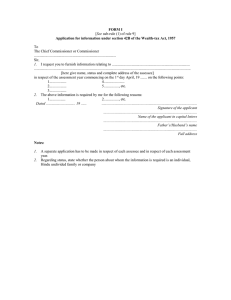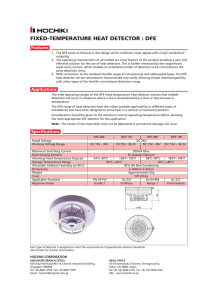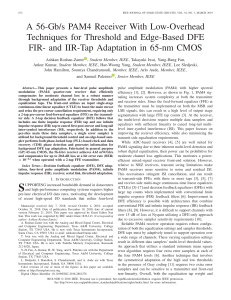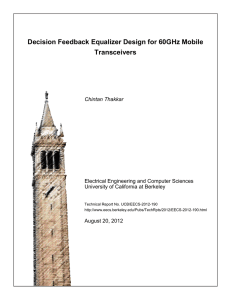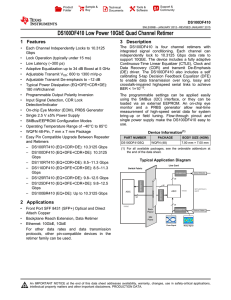How to Measure and Improve Teamwork
advertisement
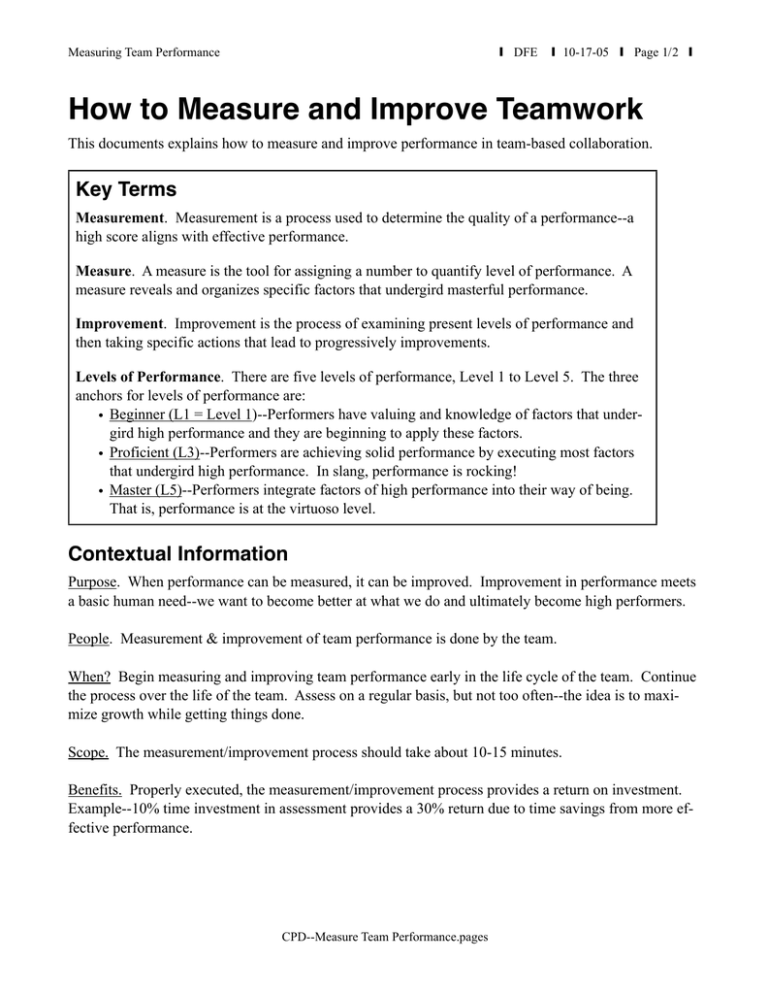
Measuring Team Performance ❙ DFE ❙ 10-17-05 ❙ Page 1/2 ❙ How to Measure and Improve Teamwork This documents explains how to measure and improve performance in team-based collaboration. Key Terms Measurement. Measurement is a process used to determine the quality of a performance--a high score aligns with effective performance. Measure. A measure is the tool for assigning a number to quantify level of performance. A measure reveals and organizes specific factors that undergird masterful performance. Improvement. Improvement is the process of examining present levels of performance and then taking specific actions that lead to progressively improvements. Levels of Performance. There are five levels of performance, Level 1 to Level 5. The three anchors for levels of performance are: • Beginner (L1 = Level 1)--Performers have valuing and knowledge of factors that undergird high performance and they are beginning to apply these factors. • Proficient (L3)--Performers are achieving solid performance by executing most factors that undergird high performance. In slang, performance is rocking! • Master (L5)--Performers integrate factors of high performance into their way of being. That is, performance is at the virtuoso level. Contextual Information Purpose. When performance can be measured, it can be improved. Improvement in performance meets a basic human need--we want to become better at what we do and ultimately become high performers. People. Measurement & improvement of team performance is done by the team. When? Begin measuring and improving team performance early in the life cycle of the team. Continue the process over the life of the team. Assess on a regular basis, but not too often--the idea is to maximize growth while getting things done. Scope. The measurement/improvement process should take about 10-15 minutes. Benefits. Properly executed, the measurement/improvement process provides a return on investment. Example--10% time investment in assessment provides a 30% return due to time savings from more effective performance. CPD--Measure Team Performance.pages Measuring Team Performance ❙ DFE ❙ 10-17-05 ❙ Page 2/2 ❙ Methodology (a step-by-step plan) 1. Set the stage a. Agree as a team to measure & improve team performance. Find an effective place and time (about 10-20 min). Provide each team member with the Measure. b. Review documentation of past team assessments. 2. Measure & assess team performance a. Ask each team member to measure team performance with the measure. Strive for honest measurement because present levels of performance can only be grown if they are honestly represented. b. Dialogue to identify present level of performance. Document present level of performance. c. Improve team performance by using assessment. Focus on the 2 to 3 most impactful strengths & improvements. Document the assessment. d. Add documentation into the assessment section in the team binder. 3. Follow up on the assessment a. Monitor project work and follow up on your assessment. That is, deepen strengths and execute action plans. b. Repeat steps 2/3 at the right frequency to lead to effective growth. If this result is not being attained, figure out why and fix the problems. c. On an as-needed basis, assess the measure and send your assessment report to Professor Elger delger@uidaho.edu. Community-wide assessment is how we improve our process. CPD--Measure Team Performance.pages Appendix A--Tool to Measure Team Performance ❙ DFE ❙ 10-18-05 ❙ Page 1/1 ❙ A Measure for Team Performance Goals-The team creates clear and motivating long-term (LT) goals and reaches these goals by creating & attaining aligned short term (ST) goals. Long Term Goals: __created __motivates team __builds powerful synergy in team Short Term Goals: __created __guide day-to-day actions __energize long term success Written LT/ST Goals?: __yes! __yes--specific & clear __yes--S.M.A.R.T. Roles & Accountability--Each team member performs in roles and takes on tasks that empower them to make both technical and collaborative (team) contributions. Regarding performance, each team member holds themselves and their peers accountable. Key Roles: __identified __clear expectations __written performance criteria Action Items (tasks): __assigned __delivered w/ quality __quality with balanced contribution Self Accountability: __valued __acted on __lived (embodied)--I commit & deliver Peer Performance: __expected __peers commit & deliver __complete trust in peers Assessment (Feedback)--Each team member helps themselves & their colleagues improve processes & performances. Focus on assessee’s needs: __attempt made __helps assessee __exactly what the assessee wants Free of judgement (+/-): __attempt made __few if any judgments __rich information without judgments Key Factors: __attempt made __identifies important factors __immediate impact to assessee Specificity: __attempt made __specific information __describes what, why, & how Clarity: __attempt made __easy to understand __direct & powerful communication Assessment frequency: __used sometimes __used often __provides optimum impact Support. Team member support their colleagues by encouraging them, by listening, and by bringing out the talents and points of view that are unique to each individual. Encouragement: __attempted __people feel encouraged __people feel energized & motivated Listening: __attempted __people feel heard __deep & shared understanding Individual talents: __team tries to ID __talents provide impact __people do what they love to do Process Approach. The team defines, documents, and applies key processes and practices to get results. Meeting process: __agreed on __effective meetings __energizing & impact-filled meetings WBS/Schedule/Scope: __agreed on __milestones reached __continuous on-time delivery & right scope Assessment process: __agreed on __noticeable growth __transformational growth Problem Solving process: __agreed on __routine problems solved __barrier jumping--innovation! Finance: __agreed on __project on budget __providing return on investment Conflict Resolution: __agreed on __conflicts solved __conflict resolution energizes team Brainstorming Process: __agreed on __produces outstanding ideas __produces innovation Documentation Practice: __agreed on __thorough & time-effective __effective in all respects Process Improvement: __agreed on __noticeable __continuous, effective, and innovative Measure Team Performance.pages Example of an Assessment Report EXAMPLE: ❙ DFE ❙ 10-18-05 ❙ Page 1 of 1 ❙ Team Assessment Monday 10/17/05 at 11:30 am 同 Strengths 1. Name. Flexible agenda. How? At start of meeting discussed, modified & agreed on agenda. Why?. Meets individual needs while providing team-based decision making. 2. Name. Assessment identified most important ideas for improvement. How? Round robin--ask for most important strength & most important improvement. Hold short dialogue and then move on & let task leader finish outside meeting time. Why? High impact for low time investment. ◈ Improvements 1. Concern. Too much focus on short term ==> missing long term thinking Recommendation. Create long term written goal & use this to guide weekly actions. Action Plan. a. next meeting, each team member presents their long term goal (3 main items) b. assemble the long term goals like a jigsaw puzzle c. write a cohesive long term goal d. use written goal as a guide 2. Concern. DL is quiet may not be getting value from being on the team. Recommendation Each team member gets value from team Action Plan. a. next week--see if goal aligns with each team member’s needs b. modify goal as needed ☯ Insights 1. Aha moment!--Shifting my role on the team really help me spend more time doing what I enjoy--this is wonderful! Transfer--Align roles with what people want to do--they will perform at a higher level and be happier. 2. Aha Moment!--It is amazing how we have shifted from long-term thinking to a focus on the crises of this week. Transfer. Continually think about where you want to end up--this eliminates clutter and reduces work. sii_dfe_10_18.pages
